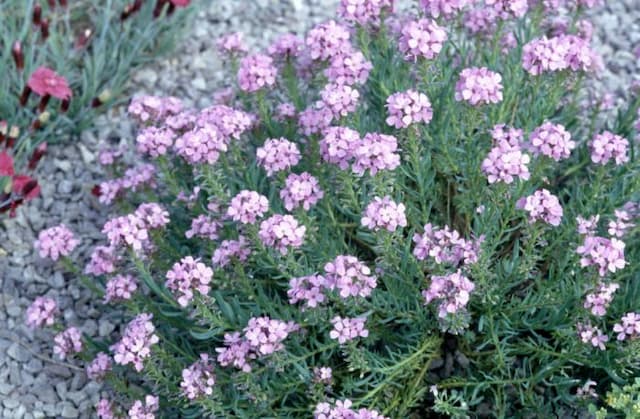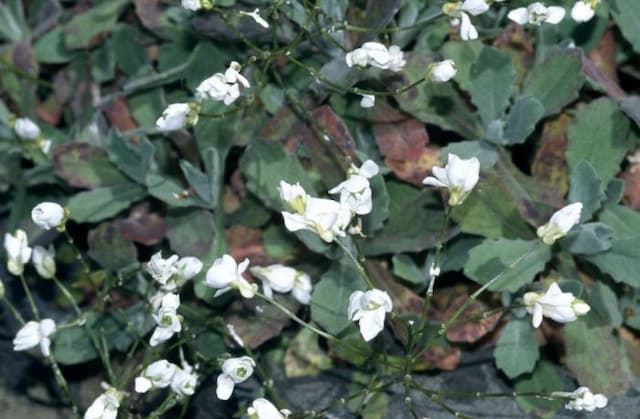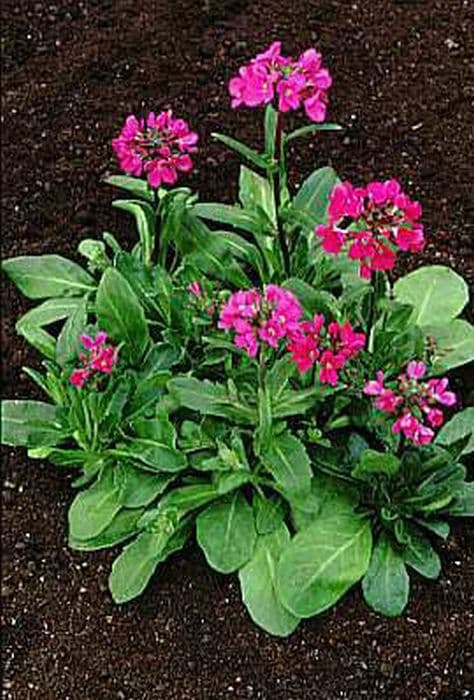Violacea Candytuft Iberis violacea

ABOUT
Iberis violacea, commonly known as purple candytuft, is a flowering plant noted for its vibrant coloration and lush foliage. The most striking feature of purple candytuft is its richly colored flowers, which, as indicated by its common name, exhibit shades of purple. The blooms are typically small and grouped in dense clusters, creating a striking display that can add a burst of color to any garden space. The leaves of purple candytuft are usually narrow and green, providing a lovely contrast against the vivid hues of the flowers. They are arranged alternately along the stems, which sprawl outwards, forming a semi-mounded shape. As a low-growing plant, purple candytuft tends to spread outwards rather than reach for height, which makes it an ideal ground cover or border plant. The plant generally blooms in the late spring to early summer, presenting a lush carpet of color that's not only beautiful to gaze upon but is also attractive to various pollinators, including butterflies and bees. Despite not delving into specifics of its size, one can envision purple candytuft as a plant that would comfortably fit within a smaller garden setting or in between larger plants, enhancing the overall aesthetic with its rich purple tones.
About this plant
 Names
NamesFamily
Brassicaceae
Synonyms
Viola Candytuft, Purple Candytuft
Common names
Iberis violacea.
 Toxicity
ToxicityTo humans
Iberis violacea, commonly referred to as purple candytuft, is not widely known for being toxic to humans. However, like with any plant, sensitivity can vary between individuals, and ingesting plant material can sometimes cause a mild stomach upset due to the unusual plant compounds. In general, it is always advisable to avoid eating plants not known to be safe for consumption to prevent any potential adverse reactions.
To pets
Purple candytuft, or Iberis violacea, does not have a widespread reputation for being toxic to pets. Nonetheless, pets, particularly dogs and cats, may have individual sensitivities to plants. Ingestion of this plant can possibly cause a mild gastrointestinal upset in some pets, resulting in symptoms like vomiting or diarrhea. It's always best to keep an eye on pets to prevent them from eating plants since they might react differently to various species. If a pet consumes any part of a plant and adverse symptoms develop, it is best to consult a veterinarian.
 Characteristics
CharacteristicsLife cycle
Perennials
Foliage type
Evergreen
Color of leaves
Green
Flower color
Varies
Height
1 foot (0.3 meters)
Spread
1 foot (0.3 meters)
Plant type
Herb
Hardiness zones
5
Native area
Mediterranean
Benefits
 General Benefits
General Benefits- Ornamental Value: Iberis violacea, commonly known as purple candytuft, adds aesthetic appeal to gardens with its vibrant purple flowers and compact growth habit.
- Pollinator Attraction: The blooms of purple candytuft are attractive to bees, butterflies, and other beneficial pollinators, contributing to the health of the local ecosystem.
- Low Maintenance: This plant is known for being easy to care for, requiring minimal watering and fertilizing, which can save time and resources for gardeners.
- Drought Tolerance: Purple candytuft is quite resilient in dry conditions, making it suitable for water-wise gardens and reducing the need for frequent irrigation.
- Soil Erosion Control: The plant's growth habit helps to stabilize soil and prevent erosion on slopes and banks.
- Seasonal Interest: With its season-long blooms, purple candytuft provides visual interest from spring to summer, enhancing the seasonal dynamics of a garden.
- Ground Cover: Due to its low and spreading nature, it can serve as an effective ground cover, suppressing weeds and covering bare spots in the landscape.
- Edging Plant: Its compact size and neat growth make purple candytuft an excellent choice for borders and edging in garden design.
 Medical Properties
Medical PropertiesThis plant is not used for medical purposes.
 Air-purifying Qualities
Air-purifying QualitiesThis plant is not specifically known for air purifying qualities.
 Other Uses
Other Uses- Iberis violacea, commonly known as purple candytuft, can be used in butterfly gardens to attract various species of butterflies with its nectar-rich blooms.
- Due to its low and compact growth habit, purple candytuft works well as an ornamental edging plant in formal garden designs.
- The plant can be considered for green roofing projects, as it is drought-resistant and can thrive in shallow soil environments.
- Purple candytuft may serve as a visual aid in garden color planning because of its vibrant purple flowers, which can complement or contrast nearby plants.
- It can be planted in rock gardens, as its ability to grow in poor soils makes it suitable for such environments.
- The plant serves beautifully in container gardening, where its overflowing nature creates cascading accents over the edges of pots or planters.
- Due to the plant's compact size, it can be used in fairy gardens to add a pop of color without overpowering the small-scale landscape.
- Purple candytuft can be utilized in xeriscaping, the practice of landscaping that reduces or eliminates the need for irrigation.
- The dried flowers of purple candytuft can be used in crafting, such as in making natural jewelry or in dried floral arrangements.
- When planted in mass, the plant can serve as ground cover, helping to prevent soil erosion in certain areas of the garden.
Interesting Facts
 Feng Shui
Feng ShuiThe Iberis violacea, commonly known as Purple Candytuft, is not used in Feng Shui practice.
 Zodiac Sign Compitability
Zodiac Sign CompitabilityThe Purple Candytuft is not used in astrology practice.
 Plant Symbolism
Plant Symbolism- Enduring Love: Iberis violacea, commonly known as Purple Candytuft, often represents lasting affection due to its perennial nature, signifying relationships that stand the test of time.
- Purity: The Purple Candytuft's delicate flowers are often associated with purity and innocence, inspiring a sense of cleanliness and virtue.
- Beauty: With its vibrant coloration, Purple Candytuft symbolizes beauty and is often given to admire someone's aesthetic qualities or grace.
- Diversity: Because it comes in various colors and can adapt to different environments, this plant can represent diversity and the acceptance of various forms of beauty.
 Water
WaterCandytuft (the common name for Iberis violacea) prefers moderate watering. During the growing season, water when the top inch of soil feels dry, which may be approximately every week, depending on the climate and humidity. Provide roughly 1 gallon of water to saturate the soil around the plant. In the winter, reduce watering to biweekly or when the soil is noticeably dry, as the plant's water requirements decrease. Overwatering can lead to root rot, so ensure good drainage.
 Light
LightCandytuft thrives best in full sunlight conditions. It should be planted in a location where it can receive at least 6 to 8 hours of direct sunlight daily. An east or south-facing spot is ideal for ensuring ample light exposure for healthy growth and flowering.
 Temperature
TemperatureCandytuft is a hardy plant that can withstand cold temperatures down to about 0°F, but it prefers a moderate climate. The ideal temperature range for this plant is between 60°F to 75°F for optimal growth. It will perform best when protected from extreme heat or frost.
 Pruning
PruningPrune Candytuft after blooming to encourage a bushy growth habit and maintain its compact shape. Typically, this means cutting back by about one-third in the late spring or early summer. Regular pruning also prevents the center of the plant from becoming woody and sparse.
 Cleaning
CleaningAs needed
 Soil
SoilCandytuft (Iberis violacea) thrives in well-draining soil that is rich in organic matter, with a neutral to slightly alkaline pH of around 7.0. A good mix comprises equal parts garden soil, compost, and coarse sand or perlite to ensure proper drainage.
 Repotting
RepottingCandytuft (Iberis violacea) does not need frequent repotting; it can be repotted every 2 to 3 years or when the plant outgrows its current container.
 Humidity & Misting
Humidity & MistingCandytuft (Iberis violacea) prefers moderate humidity levels but is quite adaptable and can thrive in the humidity levels found in most homes and gardens without needing any special treatment.
 Suitable locations
Suitable locationsIndoor
Place candytuft in bright light, away from drafts.
Outdoor
Plant in full sun, well-draining soil, water moderately.
Hardiness zone
4-9 USDA.
 Life cycle
Life cycleIberis violacea, commonly known as Purple Candytuft, begins its life cycle as a seed, typically sown in early spring directly into well-drained soil in a sunny location. Upon germination, the seedling emerges and establishes a small rosette of leaves at the soil surface. As vegetative growth progresses, Purple Candytuft develops a branching habit with lance-shaped leaves, preparing for the flowering stage. Flowering generally occurs in late spring to early summer, displaying clusters of violet or purple flowers that attract pollinators and can self-fertilize to produce seeds for the next generation. After the flowering period, seed pods develop and mature, eventually releasing seeds as the plant senesces. Many varieties of Purple Candytuft are perennial and will undergo a dormant period during the winter, emerging again with new growth in the subsequent spring.
 Propogation
PropogationPropogation time
Spring-early summer
Iberis violacea, commonly known as purple candytuft, is typically propagated through its seeds. The most popular method for propagating this plant involves sowing seeds in spring or early summer. To do so, prepare a well-draining soil mix in a flat or container and scatter the seeds on the surface, gently pressing them into contact with the soil. It's important not to cover the seeds with soil as they need light for germination. Keep the soil consistently moist until germination, which usually takes place within two to three weeks provided the temperatures are around 65 to 70 degrees Fahrenheit (approximately 18 to 21 degrees Celsius). Once the seedlings develop true leaves and are strong enough, they can be transplanted to their final location in the garden.






![Aubrieta [Axcent Burgundy]](/_next/image?url=https%3A%2F%2Fplants-admin.emdemapps.com%2Fimages%2Fplants%2F%2Fimages%2F604b5b7b548d8.png&w=640&q=75)


